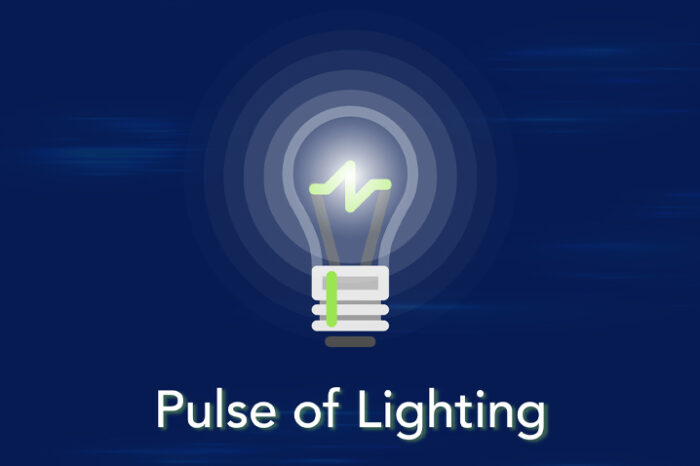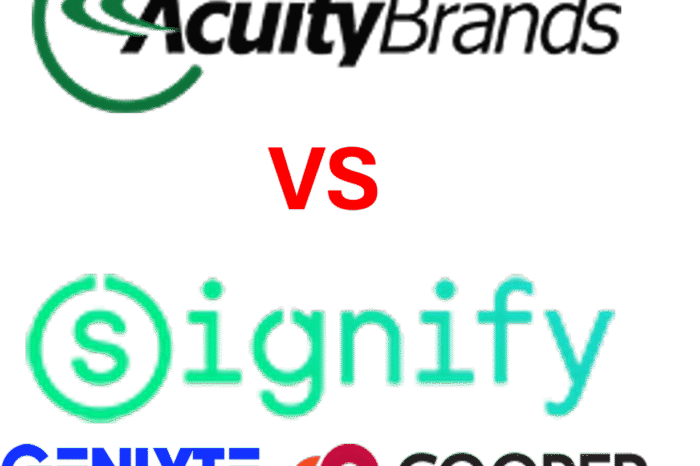Acuity Coming Back? More Visible?

Acuity appears to be slowly coming back. While their recent quarterly report (their Q1 but the industry’s Q4) showed a decline, from a channel perspective, it was only somewhat more than what respondents shared in our Q4 Pulse of Lighting report.
Digging into Acuity’s Results
In reviewing the earnings call transcript, Acuity shared:
- Overall sales down 5% to a little under $800
million for the quarter.
- “Independent channel” (agents) represented $600M
and were only down 3%. (Agents represent 75% of sales for the quarter.)
- See strength in warehouse / logistics, education and residential
- Direct sales network (primarily Holophane) was only $76M and was down 9.5% (industrial focus and “face to face” selling – many industrials are restricting sales access; some doing preventative work; some conserving cash.)
- Retail is only $55M and was up 3% (probably showing the impact of smaller contractors purchasing through big boxes, most likely for renovations, probably residential. This is a trend we see with other manufacturers.)
- National accounts were down 28% to only $24M
- “Independent channel” (agents) represented $600M
and were only down 3%. (Agents represent 75% of sales for the quarter.)
It is interesting to note that direct and national accounts are down. This is the impact of COVID and a direct salesforce. COVID has resulted in project delays, and some cancellations. Further a direct sales organization is more dependent upon face-to-face and a “complex” sales approach. It highlights the value of an agency / rep model and the challenges with the vagaries of key account selling … there are highs and lows, just need lots in the pipeline to balance it out.
- Maintained gross margin of 42% with GP dollars down to $332M, down $23M. Expenses declined $19M (so the net isn’t too much different although operating profit is up $2M due to other adjustments)
- Their “price mix” decreased 1% (which approximates what respondents told us in the Pulse of Lighting Report, from an industry perspective)
- Company has strong excessive cash flow as exhibited with them spending $255 million on stock buy-backs. Acuity reported $507M in cash / cash equivalents.
- Continuing to invest in “digital transformation” to increase transparency and communication with the channel / customers. (Question – distributor / agent feedback on this? Is this becoming a value? A point of differentiation for them in increasing share at distributors? A reason for customers to purchase from them? Lighting agents – is this making your life easier? Is it reducing your cost to provide service for your Acuity business, and will it allow you to redeploy staff and/or improve your profitability?)
- Company is seeking acquisitions, probably in more “technology” products as it called out the performance of Distech and Atrius and mentioned it is using cash to “grow our current business and invest in new businesses.”
- Focused more on contractors (as we hear feedback on focus on their Contractor Select offering.) Contractor Select is enabling Acuity to takeback some share as pricing became more competitive, supply more predictable than some alternative sources.)
- Expanding efforts in lighting controls (which will require distributors to expend more effort on being educated on capabilities and, more importantly, communicating these to contractors / customers. Same with agents. Should be more profitable for both.)
- While Acuity states they are “meaningfully outpacing the market”, this is questionable as they are underperforming based upon our results, but they may be more narrowly defining “the market” to be selected competitors. (Distributors – how is Acuity performing for you vs “the market” – defined as a broad basket of lighting manufacturers … perhaps by product category or “brand for brand”?)
- Spoke re UVC, however, there hasn’t appeared to be much traction gained within the industry in this product offering to date.
- Restructuring the business into Lighting and Intelligent Buildings (Distech and Atrius). (This probably means that Intelligent Buildings is now a “significant” part of the business to require it to be segmented on financial reports. Further, and more strategically, it probably means more focus in accelerating growth in these areas. With Acuity seeking acquisitions, expect it to be on this side of the business. The question becomes, what do they want this side of the business to be, revenue-wise, in 3-5 years? And how will it go to market … does it represent additional opportunities for agents and distributors, or will it be a different channel / sales organization?)
Analyst Questions
- Spec business has “slowed”, which means that the renovation business is where activity is (as highlighted in our Pulse of Lighting study) and this is where Contractor Select can be competitive. Acuity reportedly also has maintained its “strategic pricing” process, enabling it to target opportunities and distributor support.
- Feel impact of slow summertime spec opportunities will impact for another quarter “or so” (which would mean springtime, however, with COVID raging right now, this could be delayed a quarter, or so, increasing backlog.)
- Strong backlog
- Plan to manage price aggressively (Acuity,
and others, have announced significant price increases to go into effect
February and March (changes by company). The question will be how much is
realized. Companies are justifying this due to raw material costs. Will pricing
decline when / if these decline, reduce price “as needed” or improve
profitability?)
- Acuity stated they are at the midrange price increase with 8% (but is QSSI really an Acuity competitor? They are at a 14% increase and, knowing them, are probably willing to be aggressive if needed. Price realization won’t be known until Q2 given price increases go into effect mid-February and mid-March.)
- Highlighted that the business is very regional – mention from a +15% to a -13%.
So, overall, improving and positioning for an improving market. No major changes except for potential growth opportunities if they accelerate the Intelligent Building group … and the end-user markets rebound, which is a timing issue.
Distributors – are they improving for you?






















